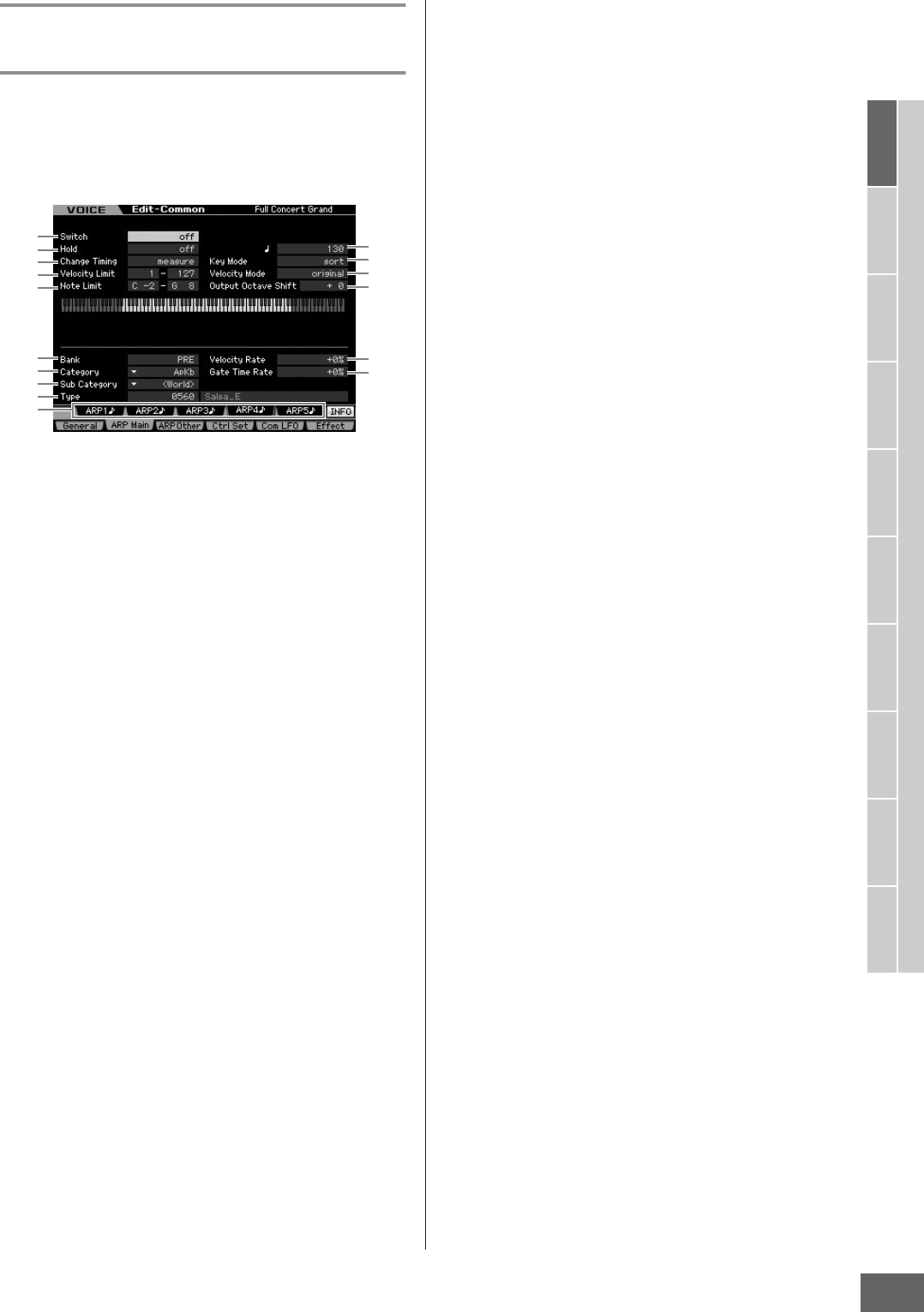
Editing a Normal Voice
MOTIF XS Owner’s Manual
101
Voice mode
Song mode
Pattern mode
Mixing mode
Master mode
Utility mode
File mode
Performance
mode
Sampling
mode 1
Sampling
mode 2
Reference
Arpeggio settings—[F2] ARP Main
(Arpeggio Main)
This display determines the basic settings of the Arpeggio.
Keep in mind that parameters Bank (!) through Gate Time
Rate Offset (^) have five settings which can be edited in
each of the [SF1] ARP1 through [SF5] ARP5 displays.
For details about Arpeggio, see page 62.
n Depending on the selected parameter, the KBD icon appears
on the tab corresponding to the [SF6] button. In this condition,
you can enter the note number or velocity by pressing the
appropriate note on the keyboard while holding the [SF6] KBD
button. For details, see page 82.
1 Switch
Determines whether Arpeggio is on or off. When calling up
a Voice for which the Common Switch is set to on, the
[ARPEGGIO ON/OFF] button on the panel will be turned on
automatically.
Settings: on, off
2 Hold*
When this is set to “on,” the Arpeggio cycles automatically,
even if you release your fingers from the keys.
Settings: sync-off (see below), off, on
sync-off
When set to “sync-off,” the Arpeggio playback continues to run silently,
even when you release the keys. Pressing any key turns the Arpeggio
playback on again, and the Arpeggio is heard from the point in the
cycle where playback is resumed.
3 Change Timing*
Determines the actual timing at which the Arpeggio type is
switched when you select another type during Arpeggio
playback. When set to “realtime,” the Arpeggio type is
switched immediately. When set to “measure,” the
Arpeggio type is switched at the top of the next measure.
Settings: realtime, measure
4 Velocity Limit
Determines the lowest and highest velocity which can
trigger the Arpeggio playback. This lets you set the velocity
range with which you press the note to trigger the Arpeggio
playback. You can also create separate low and high
trigger ranges for the Arpeggio playback, with a velocity
“hole” in the middle, by specifying the maximum value first.
For example, setting a Velocity Limit of 93 – 34 lets you play
the Arpeggio from two separate velocity ranges: soft (1 –
34) and hard (93 – 127). Notes played at middle velocities
between 35 and 92 do not play the Arpeggio.
Settings: 001 – 127
5 Note Limit
Determines the lowest and highest notes in the Arpeggio’s
note range. Notes played in this range trigger the
Arpeggio. For example, setting a Note Limit of “C5 – C4”
lets you trigger the Arpeggio by playing notes in the two
ranges of C -2 to C4 and C5 to G8; notes played between
C4 and C5 have no effect on the Arpeggio.
Settings: C -2 – G8
n Please keep in mind that no sound is produced when the Key
Mode is set to “sort” or “thru” and notes are played outside the
Note Limit setting here.
6 Tempo*
Determines the Arpeggio Tempo. This parameter can be
changed via the Knob directly.
Settings: 5 – 300
n If you are using this instrument with an external sequencer,
MIDI computer, or other MIDI device, and you want to
synchronize it to that device, set the MIDI sync (5) parameter
in the MIDI display (page 268) of the Utility mode to “MIDI” or
“auto.” In this case, the Tempo parameter here indicates
“MIDI” or “auto” and cannot be changed.
7 Key Mode
Determines how the Arpeggio plays back when playing the
keyboard.
Settings: sort, thru, direct, sort+direct, thru+direct
sort
When you play specific notes (for example, the notes of a chord), the
same sequence plays, no matter what order you play the notes.
thru
When you play specific notes (for example, the notes of a chord), the
resulting sequence differs depending on the order of the notes.
direct
Note events of the Arpeggio sequence do not play; only the notes you
play on the keyboard are heard. When the Arpeggio plays back, the
events such as Pan and Brightness are applied to the sound of your
keyboard performance. Use this setting when the Arpeggio types
includes non-note data or when the Category type “Ctrl” is selected.
sort+direct
The Arpeggio is played back according to the “sort” setting here, and
the note pressed is also sounded.
thru+direct
The Arpeggio is played back according to the “thru” setting here, and
the note pressed is also sounded.
n Some Arpeggio types belonging to the “Cntr” Category may
not have note events (page 65). When such an Arpeggio type
is selected and the Key Mode is set to “sort” or “thru,” no
sound is produced even if you press a note on the keyboard.
1
2
6
3
4
)
5
!
@
#
$
7
8
9
%
^


















